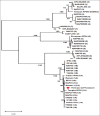Endotheliotropic herpesvirus infection in Asian elephants (Elephas maximus) of Assam, India
- PMID: 32009758
- PMCID: PMC6925033
- DOI: 10.14202/vetworld.2019.1790-1796
Endotheliotropic herpesvirus infection in Asian elephants (Elephas maximus) of Assam, India
Abstract
Background and aim: Elephant endotheliotropic herpesvirus (EEHV) is an emerging disease of elephant. Therefore, a study was conducted to know the actual status of the disease in Assam State of India.
Materials and methods: A total of 289 Asian elephants of Assam were screened during 2 years of study from April 2017 to March 2019. The clinical symptoms of diseased as well as gross and histopathological changes of dead elephants were recorded for the diagnosis of the disease. Virus involved in the occurrence of the disease was confirmed by polymerase chain reaction (PCR).
Results: In the present study, a total of three elephant calves out of 22 were found positive to EEHV1A. On the other hand, three adult asymptomatic elephants were also found positive for EEHV1 on screening 267 captive Asian elephants of Assam. The amplified PCR product showed band size of 520, 600, and 930 bp. The PCR amplified product with size 600 bp had shown the gene sequence for EEHV1U77/HEL. Gross lesions include congested blood vessels of the liver and intestinal mucosa, foci of petechiae in the spleen, and heart and focal ulceration in the dorsal surface of the tongue. Microscopically, the kidneys showed intertubular edema and focal areas of degeneration associated with coagulative necrosis of the tubular epithelium. The liver showed hydropic degeneration and fatty changes of the hepatocytes. There was a massive proliferation of fibroblasts in the interlobular spaces which penetrated the necrosed areas of the hepatic lobules.
Conclusion: A total of three wild rescued elephant calves and three asymptomatic adults were found positive for EEHV1A during the 2 years of study. The PCR amplified product with size 600 bp had shown the gene sequence for EEHV1U77/HEL.
Keywords: amplicons; amplification; elephant endotheliotropic herpesvirus; phylogenetic; polymerase chain reaction.
Copyright: © Mahato, et al.
Figures













References
-
- Richman L.K, Montali R.J, Garber R.L, Kennedy M.A, Lehnhardt J, Hildebrandt T, Schmitt D, Hardy D, Alcendor D.J, Hayward G.S. Novel endotheliotropic herpesviruses fatal for Asian and African elephants. Science. 1999;283(5405):1171–1176. - PubMed
-
- Ehlers B, Burkhardt S, Goltz M, Bergmann V, Ochs A, Weiler H, Hentschke J. Genetic and ultrastructural characterization of a European isolate of the fatal endotheliotropic elephant herpes virus. J. Gen. Virol. 2001;82(Pt 3):475–482. - PubMed
-
- Fickel J, Richman L.K, Montali R, Schaftenaar W, Goritz F, Hildebrandt T.B, Pitra C. A variant of the endotheliotropic herpes virus in Asian elephants (Elephas maximus) in European zoos. Vet. Microbiol. 2001;82(2):103–109. - PubMed
-
- Garner M.M, Helmick K, Ochsenreiter J, Richman L.K, Latimer E, Wise A.G, Maes R.K, Kiupel M, Nordhausen R.W, Zong J.C, Hayward G.S. Clinicopathologic features of fatal disease attributed to new variants of endotheliotropic herpes viruses in two Asian elephants (Elephas maximus) Vet. Pathol. 2009;46(1):97–104. - PMC - PubMed
LinkOut - more resources
Full Text Sources
Miscellaneous
